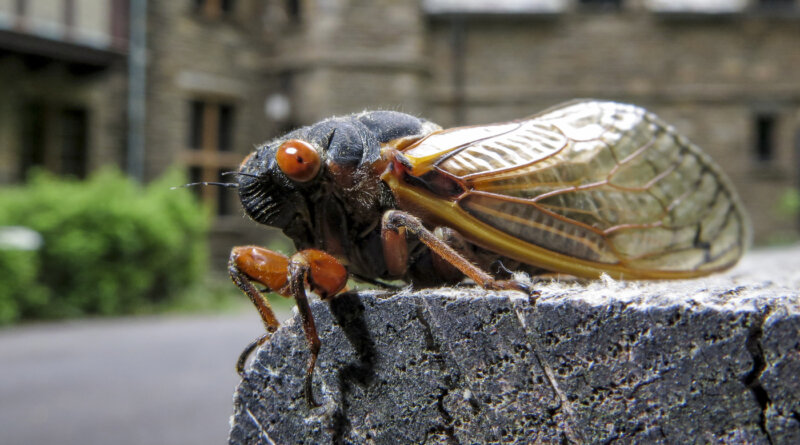As cicada emergence approaches, scientists learn more about how they pee : NPR

A cicada perches on a picnic table in front of Nolde Mansion in Cumru Township, PA in May 2021. New research shows that these insects urinate in a surprising way.
Ben Hasty / MediaNews Group/Reading Eagle via Getty Images
hide caption
toggle caption
Ben Hasty / MediaNews Group/Reading Eagle via Getty Images

A cicada perches on a picnic table in front of Nolde Mansion in Cumru Township, PA in May 2021. New research shows that these insects urinate in a surprising way.
Ben Hasty / MediaNews Group/Reading Eagle via Getty Images
This spring and summer, across the Midwest and Southeast United States, cicadas will crawl out of their underground burrows by the trillions to mate — due to two different broods of these wingèd insects emerging at about the same time, one on a 13-year cycle and one on a 17-year cycle.
In their brief several weeks aboveground, their mission will be to reproduce. Each male will attempt to attract females by producing a buzzing noise as loud as a lawnmower.
But beyond their prodigious numbers and raucous noise, new research published in PNAS reveals that cicadas are special in yet another way — their urination. Based on their size and diet, scientists suspected they’d urinate in droplets, but it turns out that these insects produce jets of pee.
The surprising results have numerous applications when it comes to manipulating fluids at small scales — including 3D printing, drug delivery, disease diagnostics, and even testing compounds in outer space.
It’s a striking discovery in a realm we know relatively little about, scientists say.
“Excretion in general is not very well understood,” says lead author Elio Challita, a bio-inspired roboticist at Harvard University. “Cicadas are some of the smallest insects, to the best of our knowledge, that can form such jets at this small scale.”
“Insects are just the perfect laboratory for exploring handling fluids at the micro-scale,” says Anne Staples, a fluid dynamicist at Virginia Tech who studies the mechanics of insect respiration and wasn’t involved in the research. “They fly through air, they drink water, they handle nectar. As this paper shows, they urinate — they excrete.”
Be that as it may, ask Challita what motivated the study, and he says it was simple curiosity. “I think people should understand science doesn’t have to be very serious,” he says. “It can be fun, too.”
A spectrum of pee
Not all animals pee in the same way. On the one hand, there are larger animals like humans and elephants. “They rely on the forces of inertia and gravity to pull down the fluids from their bladder,” says Challita.
This results in a stream or jet of urine, like the one that might hit your toilet bowl on a regular basis. In fact, a 2014 Georgia Tech study entitled “Duration of urination does not change with body size” found that all mammals more than six or seven pounds take an average of 21 seconds (plus or minus 13 seconds) to empty their bladders. The researchers referred to this as the Law of Urination.
But when an organism is small (like the size of an insect), then fluids care less about gravity. Instead, surface tension and friction dominate — forces that are negligible for larger organisms like us.
“Surface tension is an invisible kind of force that is very significant for small insects,” says Challita. “Just pushing a fluid at a small scale is challenging.”
The result is that most insects and most small mammals like mice and bats urinate in droplets through smaller orifices. In fact, while in grad school at Georgia Tech, Challita studied a kind of insect called a sharpshooter, which sucks low-nutrient sap from plants (sap that’s 95% water). “And then we calculated what is the energy required to form a jet versus a droplet,” Challita says.
It wasn’t even a contest. Droplet urination used way less energy. So that seemed to be the general rule: if you’re big, you pee in a jet. If you’re small — and especially if you’re feeding on nutrient-poor sap — you pee in droplets.
But Challita knew that the world rarely divides so cleanly. “We try to create theories that can explain things in nature,” he says, “but nature is always finding surprises and exceptions for us.”
A splash of insight
Based on a handful of YouTube videos he’d seen, Challita had a hunch that cicadas might just prove to be the exception to the rule. The only trouble is that they’re hard to observe.
“They’re usually very high up on trees,” he says. “And even if you find them, it’s hard to not disturb them and then they would fly away.”
But later, on a different project in the Peruvian Amazon, a stroke of luck: Challita and a couple colleagues had wrapped up their field work and were taking the six-hour boat ride back to town when their driver made an early pit stop for lunch.
“So we started walking around,” Challita recalls, “and then one of our colleagues, he felt this little sprinkle on his head. And then we looked up — and then we saw a lot of cicadas.”
Challita and his colleagues couldn’t believe it. There were 20 or 30 cicadas low down in the trees, feeding and peeing with abandon. The team leapt into action, rushing to collect data before their driver’s lunch break ended. They climbed one of the trees. They grabbed a table to stand on. And they filmed the cicadas using the high-speed video setting on their phones.
“All the villagers over there, they were just staring at us, like, ‘What the hell’s wrong with these guys?'” says Challita with a chuckle.
It was a rush.
And the experiment turned out well, too.
The researchers saw cicadas defying expectations. They are insects feeding on low-nutrient sap, but there they were — peeing in jets. It was one of those streams that had splashed against Challita’s colleague that had made them all look up in the first place.
YouTube
Here’s what Challita thinks is going on: Cicadas are big insects with a wider gut, so they’re not under the exact same size constraint as, say, a sharpshooter. Plus, they have to process a huge quantity of sap to extract enough energy to power their bodies.
“Peeing one droplet at a time takes too long and it’s not very efficient,” says Challita. “So they have to get rid of that fluid in jets.”
This means that in addition to large animals that pee in jets, and small animals that pee in droplets, Challita’s found a third category: small organisms that also pee in jets.
Staples says that while the research would have benefited from studying a larger number of cicadas, it still pushes the limits of our understanding.
“They’ve extended the scale into the lower reaches of the animal kingdom and showed some surprising results that are counterintuitive,” says Staples. “You wouldn’t think that this would be the most efficient exploitation of fundamental physics to urinate at that size.”
And yet it is. It’s the latest leap in the development of what Challita hopes could become a kind of Grand Urinating Theory.





